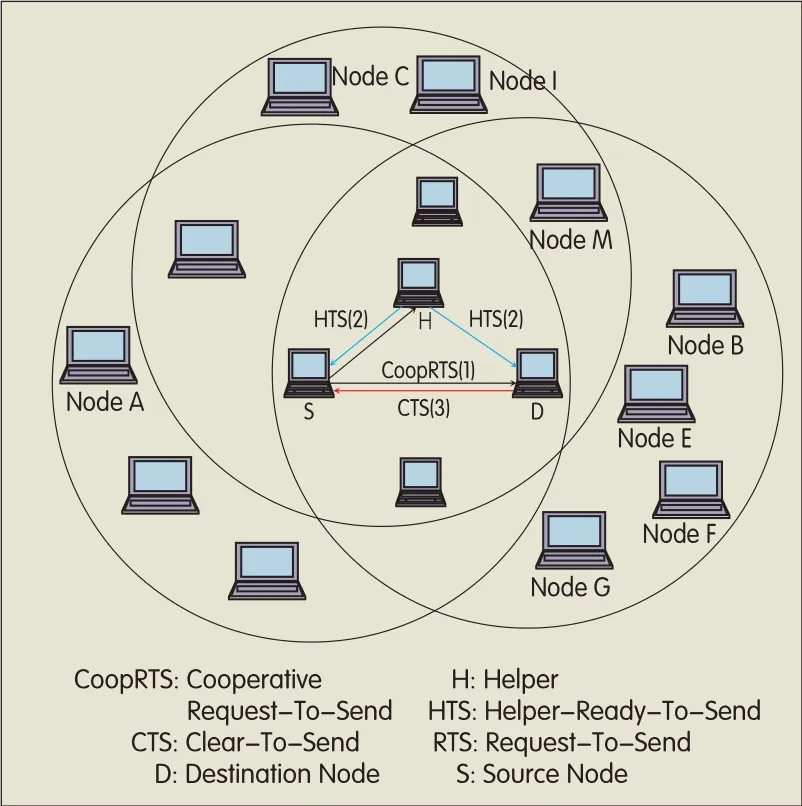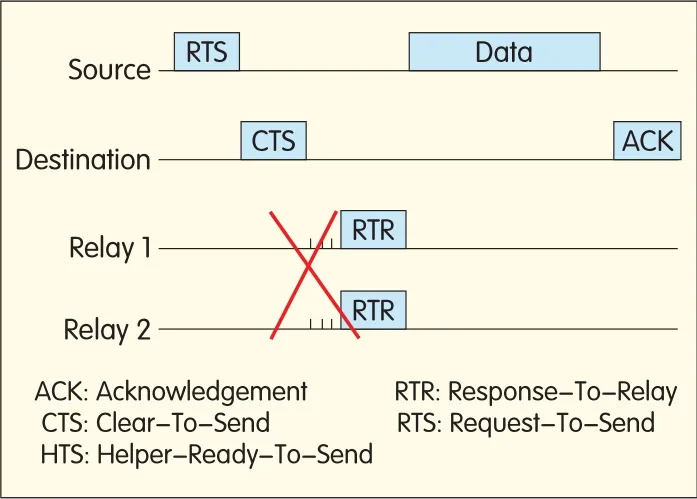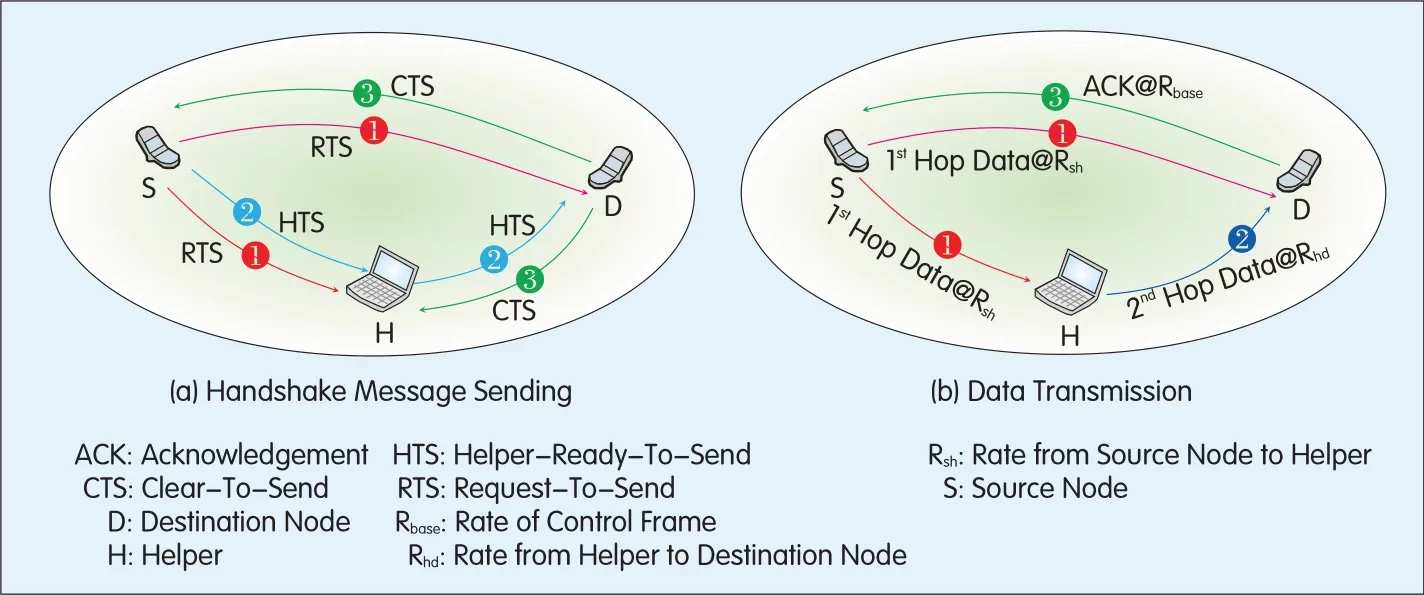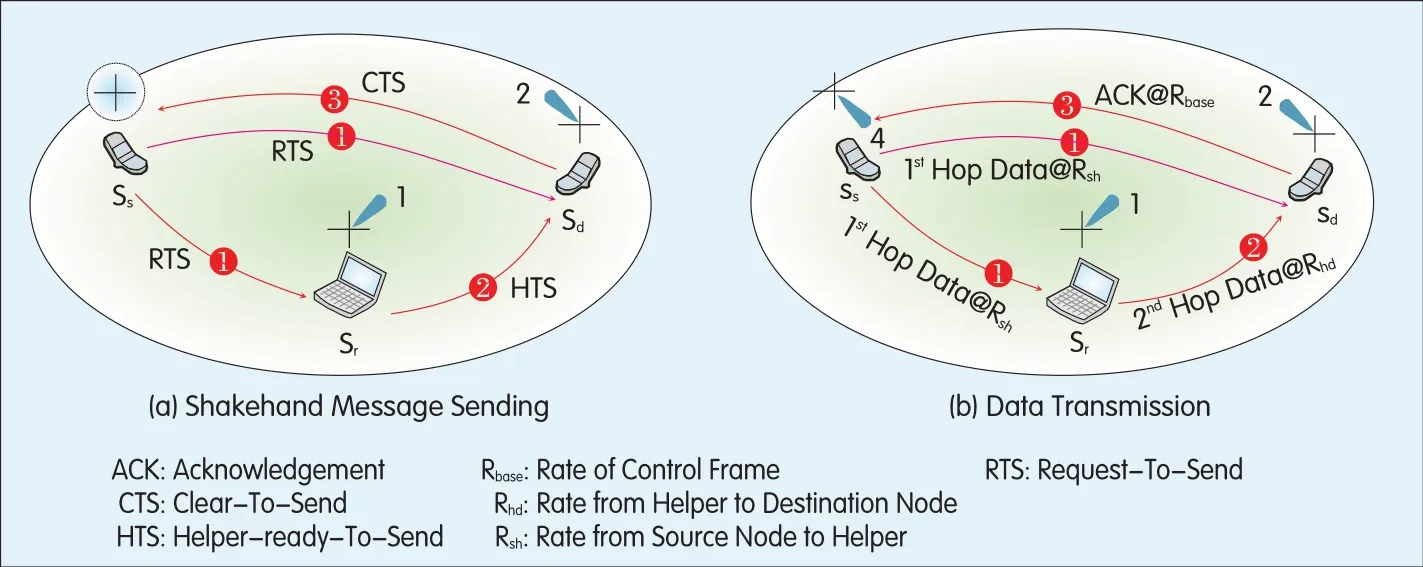MACProtocols for Distributed Cooperative Communication Networks
2010-06-18ShengMinZhangYanLiJiandong
Sheng Min Zhang Yan LiJiandong
(State Key Laboratory of Integrated Services Networks,Xidian University,Xi’an 710071,P.R.China)
Abstract:Distributed cooperative networks use the cooperation among nodes to fulfill network resource sharing.However,designing an efficient Media Access Control(MAC)protocol is a key issue for the distributed cooperative network.Based on the principle of MAC-layer cooperation,this paper discusses problems and challenges for MAC protocol design in the distributed cooperative network.Through the analysis of typical cooperative MAC protocols and their performance,this paper concludes that only a reasonable MAC protocol design with the features and demands of distributed networks taken into account can make cooperative communication technology a better application in the distributed network.
Recently,distributed networks have been attracting greater attention because of their flexible networking and easy deployment.However,multiple access protocol design still poses a significant challenge.As an emerging communication form,cooperative communication technology has also attracted close attention.Making full use of the omnidirectionalpropagation feature of radio transmission,this technology fulfills network resource sharing through cooperation among multiple nodes.Eventually,it greatly improves the performance of the entire network[1].Early research into cooperative communication technology has focused on the physical layer[1-3],but lacks detailed study on how the cooperation concept influences upper-layer protocols,especially Media Access Control(MAC)protocol.
The MAC protocol determines resource usage,and optimizing resource allocation is an important part of cooperative communication technology,therefore,good MAC protocol design in the distributed cooperative communication system is most important for maximizing the advantages of the cooperative technologies.
1 Motive of MAC Cooperation
Currently,IEEE 802.11[4]multiple access protocols are the most popular Wireless Local Area Network(WLAN)access standards,and are widely applied to testing and simulation platforms of distributed networks.The 802.11 protocols can support multiple rates on the physical layer,and make adjustments according to different channel conditions.For example,IEEE 802.11b can support the rates of 1,2,5.5 and 11 Mbit/s separately.If the distance between two nodes is great or the channel condition is bad,message transmission only occurs at low rates(eg.1 or 2 Mbit/s).This decreases the performance of the whole distributed network because not only is the transmission performance of the involved nodes influenced,but also the neighboring nodes have to wait a long time for transmission opportunities.
Therefore,it is necessary to use the cooperation among nodes to improve network performance.One simple and effective method is to introduce a helper node for improving the transmission from the source node to the destination node[5-11].If the conditions of both channels from the helper node to the source and destination nodes are good,high-speed cooperative transmission can be fulfilled.Accordingly,the saturated throughput of the entire network is improved.With the introduction of cooperative communication technology,the MAC protocol design of the distributed network becomes complex,posing new problems and challenges.
2 Problems and Challenges of Distributed Cooperative Multiple Access Protocol Design

▲Figure 1.Interaction of CoopMACcontrol frames.
2.1“Cooperation”or“Uncooperativeness”
From the standpoint of Information
Theory,cooperation always brings system gain,for example,diversity gain.However,in a real life system,the MAC protocol has to introduce overhead information to enable cooperation between nodes.This may lead to poor cooperation performance,or even totally counteract the gain brought about by the cooperation,badly impacting the system as a whole.
Therefore,in the design of a distributed network,various system parameters(such as packet length and transmission rate)should be taken into account to decide if cooperation technology is to be introduced.
2.2 Selection of Cooperative Node
The following factors should be considered when selecting the cooperative node in a distributed network:
•Rate improvement.The introduction of cooperative nodes should obviously improve the information transmission rate.
•Interference Decrease.Because the introduction of cooperation increases interference with other nodes in the network,the cooperative nodes should minimize their interference with other data flows,in order to improve space reuse of the network.
•Fairness.The cooperative node consumes its own energy to help the source node finish its communication,so full consideration of network fairness should be given before the cooperative node is selected.Excessive use of certain nodes should also be avoided.
2.3 Problems of Hidden Terminals and Exposed Terminals
Hidden terminals and exposed terminals are important problems in the distributed network.The problems become more serious with the introduction of cooperation because cooperation necessarily increases handshake messages between nodes.
They may greatly lower the probability of successful cooperation.Therefore,weakening or avoiding the influence of hidden terminal and exposed terminal problems is an important issue for the distributed cooperative protocol.Solutions include protocol optimization,and application of a smart antenna.
3 Typical Distributed Cooperative Multiple Access Protocols
(1)Coop MAC Protocol
Based on IEEE802.11 protocols,P.Liu et alproposed a Coop MAC protocol[5-6].This protocol uses high-speed nodes to help low-speed nodes finish transmission,which greatly improves network throughput,shortens the access delay of nodes,and decreases the total energy consumption of all the nodes.In Coop MAC protocol,every node maintains a cooperation table which includes the rate from the source node to a relay node,the rate from the relay node to the destination node,and the table update time.When transporting data,a node first checks the table to determine whether there is a cooperative node to use and then decides whether to use cooperative transmission.When cooperative transmission is permitted,the source node sends Cooperative Request-To-Send(Coop RTS)first;the Helper node asseses whether it can support the expected rate after correctly receiving Coop RTSand,if possible,sends a Helper-Ready-To-Send(HTS);the destination node finally responds with Clear-To-Send(CTS),and the cooperative handshake process finishes.After that,the source node sends data at a high speed to the Helper,and the Helper transfers them at high speed to the destination node.Legacy 802.11b protocol is used when no cooperative transmission is required or there is no cooperative node.The handshake process of Coop MAC protocolis shown in Figure 1.
In a fully connected network,the 3-way handshake mechanism required by cooperative transmission is not so different to the legacy RTS/CTS handshake mechanism,which just makes handshakes longer and more complex.However,in the distributed multi-hop network,the three-time handshake mechanism is influenced more by the hidden terminal problem.As shown in Figure 2,when the source node sends Coop RTS,Nodes{B,C,E,F,G,M,I}are all hidden terminals,and any may influence the correct reception of Coop RTSwhen it sends messages.When the Helper sends HTS,Nodes{B,E,F,G}are still hidden terminals.In this situation,Node B,for example,may interfere with the transmission of current handshake messages in a relative long time.Therefore,the hidden terminal problem may seriously influence the performance of Coop MAC protocol in a distributed multi-hop network.

▲Figure 2.Hidden terminalproblem of CoopMAC.

▲Figure 3.Successfulneighboring node reservation.

▲Figure 4.Collision in reservation process.

▲Figure 5.Enhanced cooperative MACprotocol.
(2)“On-Demand”Cooperative MAC Protocol
Some researchers believe each node in the Coop MAC protocol has to maintain the cooperative tables of its neighboring nodes,which increases storage overhead,and that node mobility and channel time-variance hinder the cooperative table from timely updating with the network status changes.Therefore,they have proposed proposed an“on-demand”cooperative MAC protocol[8].In this protocol,a node does not maintain any information of the cooperative node.When there is data to be sent,the source node first sends the RTSmessage,and the destination node responds to the CTSmessage after it has received the RTS.Then the potential cooperative node can obtain the channel information from the source node to itself,HSRand that from the destination node to itself,HRDthrough the above two handshake messages.Cooperative nodes compete to participate in the cooperation by setting the backoff time T,as shown in Figure 3.T is the inversely proportional function of HSRand HRD.However,in this protocol,the possibility of collision taking place during the cooperative node reservation may lead to the failure of the whole handshake process,as Figure 4 shows.
(3)Cooperative MAC Protocol with Joint Signal Decomposition
Early Coop MAC protocol uses the multi-rate transmission feature of 802.11,but only when the destination node is able to jointly decompose the signals from the source and destination nodes,can a real virtual Multiple-Input Multiple-Output(MIMO)system be built.Since signals come at different times and from different nodes,the system can obtain space and time diversity.Feilu Liu et.al.proposed a corresponding enhanced Coop MAC protocol[9],which has handshake and information transmission processes coherent with Coop MAC protocol,as shown in Figure 5.The destination receives two copies of the original packet,one from the source and one from the helper,and combines them for decoding.In a distributed multi-hop network,simulated performance of this enhanced protocol indicates about 10%throughput gain,when compared to that of the original Coop MAC protocol.However,this protocol has higher requirements of hardware devices.
(4)Cooperative MAC Protocol Supporting Directional Antenna
In terms of the network,the introduction of cooperative nodes decreases the spatial reuse level of the entire network during cooperative communications.How to make up for the loss is an important issue in cooperative MAC protocol design,and is currently of great interest to researchers[10].Zhifeng Tao et.al.proposed a D-Coop MAC protocol[11]with the condition that nodes have directionalantennas.As shown in Figure 6,when transporting data,the source node must first omnidirectionally broadcast the RTSmessage.The cooperative node,after receiving the message,then moves the transmitting antenna toward the destination and sends the HTSmessage.After successfully receiving RTSand HTS,the destination node responds with CTS to the source node;and the resultant data transmission is directional.This method resolves the decrease in network space reuse to some extent,but also increases the complexity and cost of equipment.

▲Figure 6.D-CoopMAC.
It is notable that,with the increased number of beams from directional antennas,D-Coop MAC performance is instead inferior to that of transmission directly through directionalantenna.
This is because the cooperative network needs space reuse to implement cooperation.Controlling overhead is also detrimental to network performance.Accordingly,the use of cooperation in any real network should be selective,or it may bring about the opposite result.
The above analysis of these typical cooperative MAC protocols shows that different design criteria and methods should be chosen for different network environments and configurations.This is the only way to realize the gain in cooperative communication theory and further improve the whole network performance.
4 Conclusions
In this paper,we have detailed the motives of MAC-layer cooperation in distributed networks,highlighted the problems and challenges facing the design of MAC protocols in the distributed cooperative network,and discussed typicalcooperative MAC protocols and their performance.The study of cooperative MAC protocol in the distributed network is ongoing,and designing a simple and effective cooperative MAC protocol with theoretical performance analysis will be one of the important research subjects in the future.Moreover,the existing cooperative MAC protocols involve no discussion about fairness between nodes,an issue which may throw the network into an uncooperative state.
